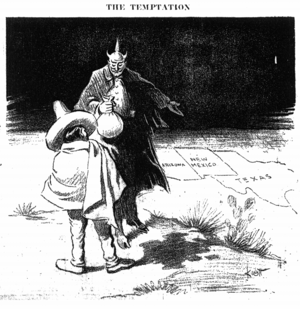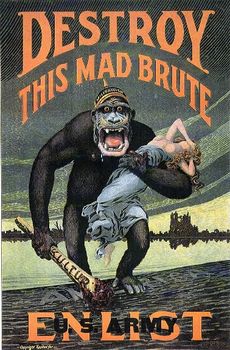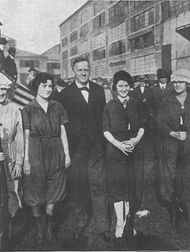الولايات المتحدة في الحرب العالمية الأولى
| الولايات المتحدة في الحرب العالمية الأولى | |||
|---|---|---|---|
| 1917–1918 | |||
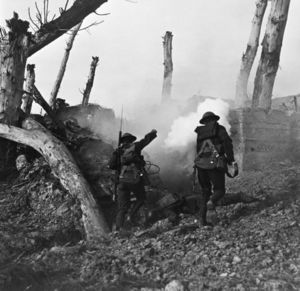 جنديان أمريكيان يركضان باتجاه ملجأ. | |||
| المكان | الولايات المتحدة | ||
| الرئيس | وودرو ولسون | ||
| الأحداث الرئيسية | Selective Service Act of 1917 Food and Fuel Control Act التجنيد | ||
| |||
| هذا المقال هو جزء من سلسلة عن |
| تاريخ الولايات المتحدة |
|---|
 |
أعلنت الولايات المتحدة الحرب على الإمبراطورية الألمانية في 6 أبريل 1917، تقريباً بعد ثلاث سنوات من اندلاع الحرب العالمية الأولى. أُعلِن وقف إطلاق نار وهدنة في 11 نوفمبر 1918. قبل دخول الحرب، ظلت الولايات المتحدة محايدة، بالرغم من أنها كان مورِّداً هاماً للمملكة المتحدة وفرنسا والدول الأخرى من حلفاء الحرب العالمية الأولى.
The U.S. made its major contributions in terms of supplies, raw material, and money, starting in 1917. American soldiers under General of the Armies John Pershing, Commander-in-Chief of the American Expeditionary Force (AEF), arrived at the rate of 10,000 men a day on the Western Front in the summer of 1918. During the war, the U.S. mobilized over 4.7 million military personnel and suffered the loss of over 116,000 soldiers.[1] The war saw a dramatic expansion of the United States government in an effort to harness the war effort and a significant increase in the size of the U.S. Armed Forces.
After a relatively slow start in mobilizing the economy and labor force, by spring 1918, the nation was poised to play a role in the conflict. Under the leadership of الرئيس وودرو ولسون، the war represented the climax of the Progressive Era as it sought to bring reform and democracy to the world. There was substantial public opposition to U.S. entry into the war.
البداية
الدخول الأمريكي في الحرب العالمية الأولى كان في 6 أبريل 1917، بعد جهد استمر عاماً من الرئيس وودرو ولسون to get the United States into the war.[بحاجة لمصدر] Apart from an Anglophile element urging early support for the British, American public opinion sentiment for neutrality was particularly strong among Irish Americans, German Americans and Scandinavian Americans,[2] as well as among church leaders and among women in general. On the other hand, even before World War I had broken out, American opinion had been more negative toward the German Empire than towards any other country in Europe.[3] Over time, especially after reports of atrocities in Belgium in 1914 and following the sinking of the passenger liner RMS Lusitania in 1915, the American people increasingly came to see the German Empire as the aggressor.
As U.S. President, it was Wilson who made the key policy decisions over foreign affairs: while the country was at peace, the domestic economy ran on a laissez-faire basis, with American banks making huge loans to Britain and France — funds that were in large part used to buy munitions, raw materials, and food from across the Atlantic. Until 1917, Wilson made minimal preparations for a land war and kept the United States Army on a small peacetime footing, despite increasing demands for enhanced preparedness. He did, however, expand the United States Navy.
In 1917, with the Russian Revolution and widespread disillusionment over the war, and with Britain and France low on credit, the German Empire appeared to have the upper hand in Europe,[4] while the Ottoman Empire clung to its possessions in the Middle East. In the same year, the German Empire decided to resume unrestricted submarine warfare against any vessel approaching British waters; this attempt to starve Britain into surrender was balanced against the knowledge that it would almost certainly bring the United States into the war. The German Empire also made a secret offer to help Mexico regain territories lost in the Mexican–American War in an encoded telegram known as the Zimmermann Telegram, which was intercepted by British Intelligence. Publication of that communique outraged Americans just as German U-boats started sinking American merchant ships in the North Atlantic. Wilson then asked Congress for "a war to end all wars" that would "make the world safe for democracy", and Congress voted to declare war on the German Empire on April 6, 1917.[5] On December 7, 1917, the U.S. declared war on Austria-Hungary.[6][7] U.S. troops began arriving on the Western Front in large numbers in 1918.
الحياد
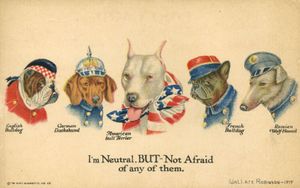
After the war began in 1914, the United States proclaimed a policy of neutrality despite President Woodrow Wilson's antipathies against the German Empire.
When the German U-boat U-20 sank the British liner Lusitania on 7 May 1915 with 128 U.S. citizens aboard, Wilson demanded an end to German attacks on passenger ships, and warned that the US would not tolerate unrestricted submarine warfare in violation of "American rights" and of "international and obligations."[8] Wilson's Secretary of State, William Jennings Bryan, resigned, believing that the President's protests against the German use of U-boat attacks conflicted with America's official commitment to neutrality. On the other hand, Wilson came under pressure from war hawks led by former president Theodore Roosevelt, who denounced German acts as "piracy",[9] and from British delegations under Cecil Spring Rice and Sir Edward Grey.
U.S. Public opinion reacted with outrage to the suspected German sabotage of Black Tom in Jersey City, New Jersey on 30 July 1916, and to the Kingsland explosion on 11 January 1917 in present-day Lyndhurst, New Jersey.[10]
Crucially, by the spring of 1917, President Wilson's official commitment to neutrality had finally unraveled. Wilson realized he needed to enter the war in order to shape the peace and implement his vision for a League of Nations at the Paris Peace Conference.[11]
الرأي العام
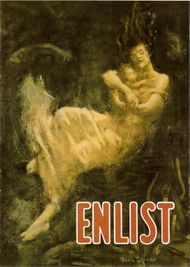
American public opinion was divided, with most Americans until early 1917 largely of the opinion that the United States should stay out of the war. Opinion changed gradually, partly in response to German actions in Belgium and the Lusitania, partly as German Americans lost influence, and partly in response to Wilson's position that America had to play a role to make the world safe for democracy.[12]
In the general public, there was little if any support for entering the war on the side of the German Empire. The great majority of German Americans, as well as Scandinavian Americans, wanted the United States to remain neutral; however, at the outbreak of war, thousands of U.S. citizens had tried to enlist in the German army.[13][14] The Irish Catholic community, based in the large cities and often in control of the Democratic Party apparatus, was strongly hostile to helping Britain in any way, especially after the Easter uprising of 1916 in Ireland.[15] Most of the Protestant church leaders in the United States, regardless of their theology, favored pacifistic solutions whereby the United States would broker a peace.[16] Most of the leaders of the women's movement, typified by Jane Addams, likewise sought pacifistic solutions.[17] The most prominent opponent of war was industrialist Henry Ford, who personally financed and led a peace ship to Europe to try to negotiate among the belligerents; no negotiations resulted.[18]
Britain had significant support among intellectuals and families with close ties to Britain.[19] The most prominent leader was Samuel Insull of Chicago, a leading industrialist who had emigrated from England. Insull funded many propaganda efforts, and financed young Americans who wished to fight by joining the Canadian military.[20][21]
حركة الاستعداد
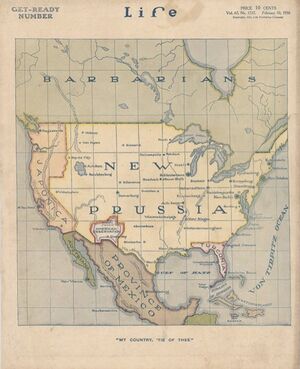
By 1915 Americans were paying much more attention to the war. The sinking of the Lusitania aroused furious denunciations of German brutality.[23] In Eastern cities a new "Preparedness" movement emerged. It argued that the United States needed to build up immediately strong naval and land forces for defensive purposes; an unspoken assumption was that America would fight sooner or later. The driving forces behind Preparedness were all Republicans, notably General Leonard Wood, ex-president Theodore Roosevelt, and former secretaries of war Elihu Root and Henry Stimson; they enlisted many of the nation's most prominent bankers, industrialists, lawyers and scions of prominent families. Indeed, there emerged an "Atlanticist" foreign policy establishment, a group of influential Americans drawn primarily from upper-class lawyers, bankers, academics, and politicians of the Northeast, committed to a strand of Anglophile internationalism.[24]
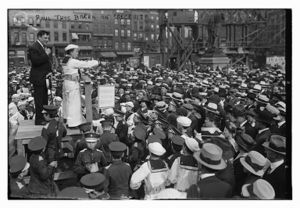
النقاش الوطني
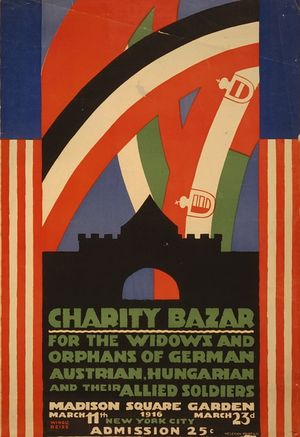
إعلان الحرب
In January 1917, the German Empire resumed unrestricted submarine warfare in hopes of forcing Britain to begin peace talks. The German Foreign minister, Arthur Zimmermann invited revolution-torn Mexico to join the war as the German Empire's ally against the United States if the United States declared war on the German Empire in the Zimmermann Telegram. In return, the Germans would send Mexico money and help it recover the territories of Texas, New Mexico and Arizona that Mexico lost during the Mexican–American War 70 years earlier.[25] British intelligence intercepted the telegram and passed the information on to Washington. Wilson released the Zimmerman note to the public and Americans saw it as a casus belli—a justification for war.
At first, Wilson tried to maintain neutrality while fighting off the submarines by arming American merchant ships with guns powerful enough to sink German submarines on the surface (but useless when the U-boats were under water). After submarines sank seven U.S. merchant ships, Wilson finally went to Congress calling for a declaration of war on the German Empire, which Congress voted on April 6, 1917.[26]
As a result of the Russian February Revolution in 1917, the Tsar abdicated and was replaced by a Russian Provisional Government. This helped overcome Wilson's reluctance to having the U.S. fight alongside a country ruled by an absolutist monarch. Pleased by the Provisional Government's pro-war stance, the U.S. accorded the new government diplomatic recognition on March 9, 1917.[27]
Furthermore, as the war raged on Wilson started to increasingly see belligerency in the war as a ticket to the international conferences that would undoubtedly follow the war's end. This was part of his wider mission to make the United States a more instrumental player on the global stage (which he would later expand upon in his Fourteen points).[28]
Congress declared war on the Austro-Hungarian Empire on December 7, 1917,[29] but never made declarations of war against the other Central Powers, Bulgaria, the Ottoman Empire or the various small co-belligerents allied with the Central Powers.[30] Thus, the United States remained uninvolved in the military campaigns in central and eastern Europe, the Middle East, the Caucasus, North Africa, Sub-Saharan Africa, Asia and the Pacific.
الجبهة الداخلية
The home front required a systematic mobilization of the entire population and the entire economy to produce the soldiers, food supplies, munitions, and money needed to win the war. It took a year to reach a satisfactory state. Although the war had already raged for two years, Washington had avoided planning, or even recognition of the problems that the British and other Allies had to solve on their home fronts. As a result, the level of confusion was high at first. Finally efficiency was achieved in 1918.[31]
The war came in the midst of the Progressive Era, when efficiency and expertise were highly valued. Therefore, the federal government set up a multitude of temporary agencies with 50,000 to 1,000,000 new employees to bring together the expertise necessary to redirect the economy into the production of munitions and food necessary for the war, as well as for propaganda purposes.[32]
الطعام
The most admired agency for efficiency was the United States Food Administration under Herbert Hoover. It launched a massive campaign to teach Americans to economize on their food budgets and grow victory gardens in their backyards for family consumption. It managed the nation's food distribution and prices and built Hoover's reputation as an independent force of presidential quality.[33]
التمويل
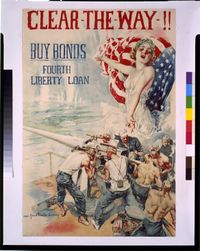
In 1917 the government was unprepared for the enormous economic and financial strains of the war. Washington hurriedly took direct control of the economy. The total cost of the war came to $33 billion, which was 42 times as large as all Treasury receipts in 1916. A constitutional amendment legitimized income tax in 1913; its original very low levels were dramatically increased, especially at the demand of the Southern progressive elements. North Carolina Congressman Claude Kitchin, chairman of the tax-writing Ways and Means Committee argued that since Eastern businessman had been leaders in calling for war, they should pay for it.[34] In an era when most workers earned under $1000 a year, the basic exemption was $2,000 for a family. Above that level taxes began at the 2 percent rate in 1917, jumping to 12 percent in 1918. On top of that there were surcharges of one percent for incomes above $5,000 to 65 percent for incomes above $1,000,000. As a result, the richest 22 percent of American taxpayers paid 96 percent of individual income taxes. Businesses faced a series of new taxes, especially on "excess profits" ranging from 20 percent to 80 percent on profits above pre-war levels. There were also excise taxes that everyone paid who purchased an automobile, jewelry, camera, or a motorboat.[35][36] The greatest source of revenue came from war bonds, which were effectively merchandised to the masses through an elaborate innovative campaign to reach average Americans. Movie stars and other celebrities, supported by millions of posters, and an army of Four-Minute Men speakers explained the importance of buying bonds. In the third Liberty Loan campaign of 1918, more than half of all families subscribed. In total, $21 billion in bonds were sold with interest from 3.5 to 4.7 percent. The new Federal Reserve system encouraged banks to loan families money to buy bonds. All the bonds were redeemed, with interest, after the war. Before the United States entered the war, New York banks had loaned heavily to the British. After the U.S. entered in April 1917, the Treasury made $10 billion in long-term loans to Britain, France and the other allies, with the expectation the loans would be repaid after the war. Indeed, the United States insisted on repayment, which by the 1950s eventually was achieved by every country except Russia.[37][38]
المرأة والعمل
السيارات
Before the American entry into the war, many American-made heavy four-wheel drive trucks, notably made by Four Wheel Drive (FWD) Auto Company, and Jeffery / Nash Quads, were already serving in foreign militaries, bought by Great Britain, France and Russia. When the war started, motor vehicles had begun to replace horses and pulled wagons, but on the European muddy roads and battlefields, two-wheel drive trucks got stuck all the time, and the leading allied countries could not produce 4WD trucks in the numbers they needed.[39] The U.S. Army wanted to replace four-mule teams used for hauling standard 11⁄2 U.S. ton (3000 lb / 1.36 metric ton) loads with trucks, and requested proposals from companies in late 1912.[40] This led the Thomas B. Jeffery Company to develop a competent four-wheel drive, 11⁄2 short ton capacity truck by July 1913: the "Quad".
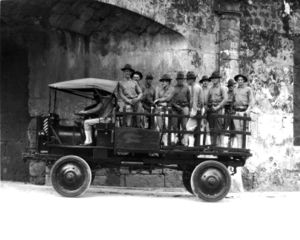
The Jeffery Quad truck, and from the company's take-over by Nash Motors after 1916, the Nash Quad, greatly assisted the World War I efforts of several Allied nations, particularly the French.[41] The U.S. first adopted Quads in anger in the USMC's occupations of Haiti, and the Dominican Republic, from 1915 through 1917,[42] as well as in the 1916 Pancho Villa Expedition against Mexico. Once the U.S. entered World War I, general John Pershing used Nash Quads heavily in the European campaigns. They became the workhorse of the Allied Expeditionary Force there — both as regular transport trucks, and in the form of the Jeffery armored car.[43][44] Some 11,500 Jeffery / Nash Quads were built between 1913 and 1919.[45]
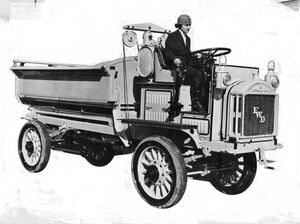
The success of the Four Wheel Drive cars in early military tests had prompted the U.S. company to switch from cars to truck manufacturing. For World War I, the U.S. Army ordered an amount of 15,000 FWD Model B, three-ton (6000 lb / 2700 kg) capacity trucks, as the "Truck, 3 ton, Model 1917", with over 14,000 actually delivered. Additional orders came from the United Kingdom and Russia.[46] Once the FWD and Jeffery / Nash four-wheel drive trucks were required in large numbers in World War I, both models were built under license by several additional companies to meet demand. The FWD Model B was produced under license by four additional manufacturers.[47]
The Quad and the FWD trucks were the world's first four-wheel drive vehicles to be made in five-figure numbers, and they incorporated many hallmark technological innovations, that also enabled the decisive U.S. and Allied usage of 4x4 and 6x6 trucks subsequently in World War II. The Quad's production continued for 15 years with a total of 41,674 units made.[48]
Socially, it was the FWD company that employed Luella Bates, believed to be the first female truck driver, chosen to work as test and demonstration driver for FWD, from 1918 to 1922.[49] [50] During World War I, she was a test driver traveling throughout the state of Wisconsin in an FWD Model B truck. After the war, when the majority of the women working at Four Wheel Drive were let go, she remained as a demonstrator and driver.[49]
العسكرية الأمريكية
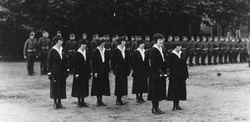
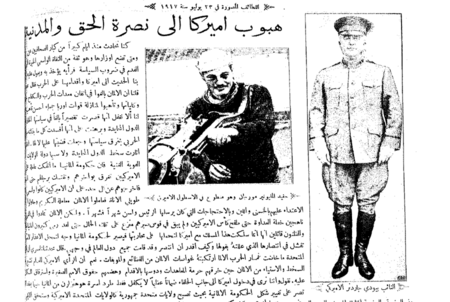
وقع القوات الأمريكية على الحرب
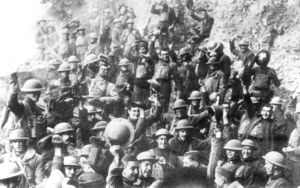
On the battlefields of France in spring 1918, the war-weary Allied armies enthusiastically greeted the fresh American troops. They arrived at the rate of 10,000 a day,[51] at a time when the Germans were unable to replace their losses. The Americans won a victory at Cantigny, then again in defensive stands at Chateau-Thierry and Belleau Wood. The Americans helped the British Empire, French and Portuguese forces defeat and turn back the powerful final German offensive (Spring Offensive of March to July, 1918), and most importantly, the Americans played a role in the Allied final offensive (Hundred Days Offensive of August to November). However, many American commanders used the same flawed tactics which the British, French, Germans and others had abandoned early in the war, and so many American offensives were not particularly effective. Pershing continued to commit troops to these full-frontal attacks, resulting in high casualties without noticeable military success against experienced veteran German and Austrian-Hungarian units. Nevertheless, the infusion of new and fresh U.S. troops greatly strengthened the Allies' strategic position and boosted morale. The Allies achieved victory over the German Empire on November 11, 1918 after German morale had collapsed both at home and on the battlefield.[52][53]
بعد الحرب
The government promptly canceled wartime contracts, ended the draft, and started to bring home its troops from Europe as fast as transport became available.[54] However, there was no GI Bill or financial or educational benefits for veterans, and the lack became a major political issue, especially for the large veterans' groups such as the Veterans of Foreign Wars and the new American Legion.[55] The readjustment period was marked by soaring unemployment, massive strikes, and race riots in 1919. The public demanded a return to "normalcy", and repudiated Wilson with the election of conservative Republican Warren G. Harding.[56]
انظر أيضاً
- United States campaigns in World War I
- History of the United States (1865–1918)
- German prisoners of war in the United States
- General Pershing WWI casualty list
- جائحة الانفلونزا الاسبانية
المراجع
- ^ DeBruyne, Nese F. (2017). American War and Military Operations Casualties: Lists and Statistics. Congressional Research Service. Archived from the original. You must specify the date the archive was made using the
|archivedate=parameter. https://fas.org/sgp/crs/natsec/RL32492.pdf. - ^ Jeanette Keith (2004). Rich Man's War, Poor Man's Fight: Race, Class, and Power in the Rural South during the First World War. U. of North Carolina Press. pp. 1–5. ISBN 978-0-8078-7589-6.
- ^ Barnes, Harry Elmer. The Genesis of the World War (1925) pp. 590–591
- ^ "World War One". BBC History. Archived from the original on 2020-11-06. Retrieved 2019-12-25.
- ^ Link, Arthur S. (1972). Woodrow Wilson and the Progressive Era, 1910–1917. New York: Harper & Row. pp. 252–282.
- ^ H.J.Res.169: Declaration of War with Austria-Hungary, WWI Archived 2021-11-25 at the Wayback Machine, United States Senate
- ^ Jennifer K. Elsea; Matthew C. Weed (April 18, 2014). "Declarations of War and Authorizations for the Use of Military Force: Historical Background and Legal Implications" (PDF). p. 9. Archived (PDF) from the original on August 10, 2006. Retrieved July 21, 2014.
- ^ "Wilson's First Lusitania Note to Germany - World War I Document Archive". wwi.lib.byu.edu. Archived from the original on 2017-04-22. Retrieved 2020-03-06.
- ^ H.W. Brands, T.R.: The Last Romantic (1997) p=756
- ^ Jules Witcover, Black Tom: Imperial Germany's Secret War in America (1989). Also in January 1917, the Zimmerman Telegram, through which the German government sought to enlist Mexico as an ally and instigate a Mexican invasion of the U.S., was leaked, further inflaming anti-German sentiment.
- ^ Karp 1979
- ^ Ernest R. May, The World War and American Isolation, 1914-1917 (1959)
- ^ Hew Strachan, The First World War (2003)
- ^ TV Series, The First World War Part 7: Blockade Archived 2017-02-10 at the Wayback Machine (2003)
- ^ William M. Leary, Jr., "Woodrow Wilson, Irish Americans, and the Election of 1916," Journal of American History Vol. 54, No. 1 (Jun. 1967), pp. 57-72 JSTOR 1900319
- ^ Patricia Appelbaum, Kingdom to Commune: Protestant Pacifist Culture between World War I and the Vietnam Era (2009)
- ^ Frances H. Early, A World without War: How U.S. Feminists and Pacifists Resisted World War I (1997)
- ^ Barbara S. Kraft, The peace ship: Henry Ford's pacifist adventure in the First World War (1978)
- ^ H. C. Peterson, Propaganda for War: The Campaign Against American Neutrality, 1914-1917 (1968)
- ^ Forrest McDonald, Insull: The Rise and Fall of a Billionaire Utility Tycoon (2004)
- ^ "Constitution Act, 1867". Her Majesty the Queen in Right of Canada. March 29, 1867. p. s.9. Retrieved September 3, 2012.
- ^ @historyinmemes (2023-06-1). "The Allies of World War I crafted this propaganda map in 1916". تويتر.
{{cite web}}: Check date values in:|date=(help) - ^ Frank Trommler, "The Lusitania Effect: America's Mobilization against Germany in World War I" German Studies Review 32#2 (2009), pp. 241-266 online Archived 2020-08-20 at the Wayback Machine
- ^ Priscilla Roberts, "Paul D. Cravath, the First World War, and the Anglophile Internationalist Tradition." Australian Journal of Politics and History 2005 51(2): 194-215. ISSN 0004-9522 DOI:10.1111/j.1467-8497.2005.00370.x
- ^ Barbara Tuchman, The Zimmerman Telegram (1966)
- ^ see: Woodrow Wilson declares war on Germany.
- ^ Richard Pipes A Concise History of the Russian Revolution, Vintage Books 1996 p.93
- ^ Hannigan, Robert (2017). The Great War and American foreign policy, 1914-24 (1st ed.). University of Pennsylvania Press. p. 96.
- ^ Official Declarations of War by Congress Archived 2015-01-21 at the Wayback Machine - Senate.gove
- ^ "US declaration of war against Austria-Hungary | The Gilder Lehrman Institute of American History". Gilderlehrman.org. 1917-12-07. Archived from the original on 2016-09-22. Retrieved 2016-11-06.
- ^ David Kennedy, Over Here
- ^ Spencer Tucker and Priscilla Mary Roberts, eds., World War I: encyclopedia (2005), p. 1205
- ^ George H. Nash, The Life of Herbert Hoover: Master of Emergencies, 1917-1918 (1996)
- ^ Alex Mathews Arnett, "Claude Kitchin Versus the Patrioteers," North Carolina Historical Review 14#1 (1937), pp. 20-30 online Archived 2020-01-13 at the Wayback Machine
- ^ Stewart D. Brandes, "Financing World War I" in John P. Resch, ed., Americans at War: Society, culture, and the home front: volume 3:1901-1945 (2005) 3: 57-59.
- ^ David M. Kennedy, Over here: The first world war and American society (2004) pp 93-144.
- ^ Charles Gilbert, American financing of World War I (1970)
- ^ Brandes, (2005)
- ^ produced by UAW and Jeep (27 September 2007). Jeep: Steel Soldier (documentary). "Toledo Stories": PBS. Event occurs at 2:08–2:51 min. Archived from the original on 2021-12-20. Retrieved 2020-10-21.
- ^ Adolphus, David Traver (August 2011). "Where none could possibly travel Jeffery's Quads became the backbone of both commerce and war". Hemmings Classic Car. Archived from the original on 5 March 2018. Retrieved 4 March 2018.
- ^ Shrapnell-Smith, Edmund (1915). Our Despatches from the Front: Huge Deliveries of Lorries for the French Government. Drivers for Quads. American Tire Sizes, in The Commercial Motor. Temple Press (since 2011, Road Transport Media). p. 229. Archived from the original on 8 December 2014. Retrieved 6 December 2014.
- ^ Buckner, David N. (1981). Marine Corps Historical Division (ed.). A Brief History of the 10th Marines (PDF). Washington D.C.: United States Marine Corps. 19000308400. Archived (PDF) from the original on 28 December 2016. Retrieved 3 March 2018.
- ^ Hyde, Charles (2009). The Thomas B. Jeffery Company, 1902-1916, in Storied Independent Automakers. Wayne State University Press. pp. 1–20. ISBN 978-0-8143-3446-1. Archived from the original on 20 January 2023. Retrieved 6 December 2014.
- ^ "Charles Thomas Jeffery". The Lusitania Resource. 25 July 2011. Archived from the original on 16 May 2019. Retrieved 6 December 2014.
- ^ Mroz, Albert (2009). American Military Vehicles of World War I: An Illustrated History of Armored Cars, Staff Cars, Motorcycles, Ambulances, Trucks, Tractors and Tanks. McFarland. p. 19. ISBN 978-0-7864-3960-7.
- ^ "FWD Model B". Military Factory. Military Factory. Archived from the original on March 5, 2018. Retrieved March 4, 2018.
- ^ Karolevitz, Robert (1966). This Was Trucking: A Pictorial History of the first quarter century of the trucking industry. Seattle: Superior Publishing Company. p. 100. ISBN 0-87564-524-0.
- ^ Redgap, Curtis; Watson, Bill (2010). "The Jefferys Quad and Nash Quad — 4x4 Ancestor to the Willys Jeep". Allpar. Archived from the original on 8 December 2014. Retrieved 6 December 2014.
- ^ أ ب "Can a Girl Be As Good a Mechanic As a Man Is Question". Monongahela Pennsylvania Daily Republican. June 30, 1920. Archived from the original on March 6, 2016. Retrieved October 31, 2020 – via Newspapers.com.

- ^ Karolevitz (1966), page 43.
- ^ خطأ استشهاد: وسم
<ref>غير صحيح؛ لا نص تم توفيره للمراجع المسماةhistoryplace.com - ^ Ferguson, Niall (1998). The Pity of War. Penguin.
- ^ Edward M. Coffman, The War to End All Wars: The American Military Experience in World War I (1998)
- ^ Dixon Wecter, When Johnny Comes Marching Home (1970).
- ^ David Ortiz, Beyond the Bonus March and GI Bill: how veteran politics shaped the New Deal era (2013) p xiii
- ^ Burl Noggle, Into the Twenties – The United States From Armistice to Normalcy (1974).
للاستزادة
- Bassett, John Spencer. Our War with Germany: A History (1919) online edition
- Breen, William J. Uncle Sam at Home: Civilian Mobilization, Wartime Federalism, and the Council of National Defense, 1917-1919 (1984))
- Byerly, Carol R. (2010). "The U.S. Military and the Influenza Pandemic of 1918–1919". Public Health Reports. United States National Library of Medicine. 125 (Suppl 3): 82–91. doi:10.1177/00333549101250S311. ISSN 1468-2877. PMC 2862337. PMID 20568570.
{{cite journal}}: Invalid|ref=harv(help) - Capozzola, Christopher. Uncle Sam Wants You: World War I and the Making of the Modern American Citizen (2008)
- Chambers, John W., II. To Raise an Army: The Draft Comes to Modern America (1987)
- Clements, Kendrick A. The Presidency of Woodrow Wilson (1992)
- Coffman, Edward M. The War to End All Wars: The American Military Experience in World War I (1998), a standard military history. online free to borrow
- Committee on Public Information. How the war came to America (1917) online 840pp detailing every sector of society
- Cooper, John Milton. Woodrow Wilson: A Biography (2009)
- Cooper, John Milton. "The World War and American Memory." Diplomatic History (2014) 38#4 pp: 727-736.
- Doenecke, Justus D. Nothing Less than War: A New History of America's Entry into World War I (University Press of Kentucky, 2011)
- DuBois, W.E. Burghardt, "An Essay Toward a History of the Black Man in the Great War," The Crisis, vol. 18, no. 2 (June 1919), pp. 63–87.
- Epstein, Katherine C. “The Conundrum of American Power in the Age of World War I,” Modern American History (2019): 1-21.
- Hannigan, Robert E. The Great War and American Foreign Policy, 1914–24 (U of Pennsylvania Press, 2017)C
- Kennedy, David M. Over Here: The First World War and American Society (2004), comprehensive coverage
- Malin, James C. The United States After the World War (1930) online
- Marrin, Albert. The Yanks Are Coming: The United States in the First World War (1986)
- May, Ernest R. The World War and American Isolation, 1914-1917 (1959) online at ACLS e-books, highly influential study
- Nash, George H. The Life of Herbert Hoover: Master of Emergencies, 1917-1918 (1996) excerpt and text search
- Paxson, Frederic L. Pre-war years, 1913-1917 (1936) wide-ranging scholarly survey
- Paxson, Frederic L. American at War 1917-1918 (1939) wide-ranging scholarly survey online free
- Resch, John P., ed. Americans at War: Society, culture, and the home front: volume 3:1901-1945 (2005)
- Schaffer, Ronald. America in the Great War: The Rise of the War-Welfare State (1991)
- Snow, William J. Signposts of Experience: World War Memoits of Major General William J. Snow, USA-Retired, Chief of Field Artillery 1918-1927. CreateSpace Independent Publishing Platform, May 15, 2014. ISBN 978-1499673777.
- Trask, David F. The United States in the Supreme War Council: American War Aims and Inter-Allied Strategy, 1917–1918 (1961)
- Trask, David F. The AEF and Coalition Warmaking, 1917–1918 (1993) online free
- Tucker, Spencer C., and Priscilla Mary Roberts, eds. The Encyclopedia of World War I : A Political, Social, and Military History (5 vol. 2005)
- Van Ells, Mark D. "America and World War I: A Traveler's Guide" (2014)
- Vaughn, Stephen. Holding Fast the Inner Lines: Democracy, Nationalism, and the Committee on Public Information (University of North Carolina Press, 1980)
- Venzon, Anne ed. The United States in the First World War: An Encyclopedia (1995)
- Walworth, Arthur (1958). Woodrow Wilson, Volume I, Volume II. Longmans, Green.; 904pp; full scale scholarly biography; winner of Pulitzer Prize; online free; 2nd ed. 1965
- Wevera, Peter C Wevera; van Bergenc, Leo (June 27, 2014). "Death from 1918 pandemic influenza during the First World War: a perspective from personal and anecdotal evidence". Influenza Other Respir Viruses. 8 (5): 538–46. doi:10.1111/irv.12267. PMC 4181817. PMID 24975798.
{{cite journal}}: Invalid|ref=harv(help) - Woodward, David R. The American Army and the First World War (2014). 484 pp. online review
- Woodward, David R. Trial by Friendship: Anglo-American Relations, 1917-1918 (1993) online
- Young, Ernest William. The Wilson Administration and the Great War (1922) online edition
- Zieger, Robert H. America's Great War: World War I and the American Experience (2000)
التاريخانية والذاكرة
- Berg, Manfred, and Axel Jansen. "Americans in World War I–World War I in America." Journal of the Gilded Age and Progressive Era 17.4 (2018): 599-607. excerpt
- Capozzola, Chris, et al. "Interchange: World War I." Journal of American History 102.2 (2015): 463-499. https://doi.org/10.1093/jahist/jav474
- Cooper, John Milton Jr. “The World War and American Memory,” Diplomatic History 38:4 (2014): 727–36.
- Jones, Heather. “As the Centenary Approaches: The Regeneration of First World War Historiography” Historical Journal 56:3 (2013): 857–78, global perspective
- Keene, Jennifer, “The United States” in John Horne, ed., A Companion to World War I (Wiley-Blackwell, 2012), 508–23.
- Keene, Jennifer D. "Remembering the 'Forgotten War': American Historiography on World War I." Historian 78#3 (2016): 439-468. online
- Rubin, Richard. The Last of the Doughboys: The Forgotten Generation and their Forgotten World War (2013)
- Snell, Mark A., ed. Unknown Soldiers: The American Expeditionary Forces in Memory and Remembrance (Kent State UP, 2008).
- Woodward. David. America and World War I: A Selected Annotated Bibliography of English Language Sources (2nd ed 2007) excerpt
- Zeiler, Thomas W., Ekbladh, David K., and Montoya, Benjamin C., eds. Beyond 1917: The United States and the Global Legacies of the Great War (Oxford University Press, 2017)
وصلات خارجية
- First-hand accounts of World War I veterans, The Library of Congress Veterans History Project.
